
The orange threadtail or ochre threadtail is an Australian damselfly in the family Platycnemididae. They are medium-sized with a length of around 35mm. Orange threadtails can be found near semi-shaded running water, and usually rest on plants at the water's edge. Orange threadtails may be seen all year round. In Victoria they occur at lower altitudes during summer, though further north they can be seen in spring and autumn. When at rest, Nososticta damselflies hold their wings closely folded up vertically over their thorax. The male threadtails have an orange-yellow thorax with black patterns. Their abdomen is narrow, black in colour with yellow strips. There is a brown yellow colour at the base of their wings. Females are the same size as the males. They are pale brown in colour and have the same black patterns as the males.

Procordulia affinis is a species of dragonfly in the family Corduliidae, known as the western swamp emerald. It inhabits rivers, pools and lakes in south-western Australia.
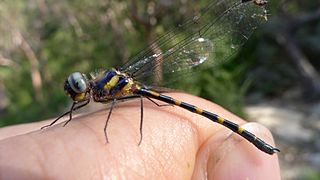
Cordulephya pygmaea is a species of dragonfly of the family Cordulephyidae, also known as the common shutwing. It inhabits streams in eastern Australia. It is small to tiny in size, coloured black, or purplish-black, with yellowish markings. It rests with its wings folded above its body in a similar manner to a damselfly.
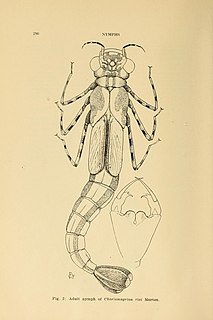
Chorismagrion is a monotypic genus of damselflies belonging to the family Synlestidae. The single species of this genus, Chorismagrion risi, known as a pretty relict, is a slender, medium-sized damselfly, mostly black in colour with white markings. It is endemic to north-eastern Australia, where it inhabits streams and large pools in rainforests.

Pseudagrion ignifer is a species of damselfly in the family Coenagrionidae, commonly known as a flame-headed riverdamsel. It is a medium-sized damselfly with an orange face and pruinose sides to its body and the start of its tail. It is found in eastern Australia, where it inhabits streams.
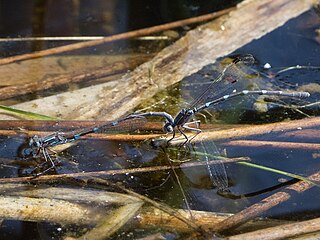
Austrolestes io is an Australian species of damselfly in the family Lestidae, commonly known as an iota ringtail. It has been found in both south-western Australia as well as south-eastern Australia where it inhabits pools, lakes and ponds.
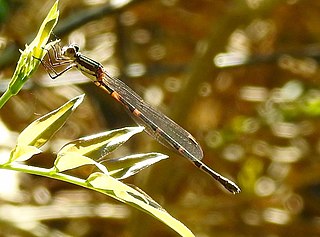
Austrolestes leda is an Australian species of damselfly in the family Lestidae, commonly known as a wandering ringtail. It is found across eastern Australia where it inhabits slow and still water.
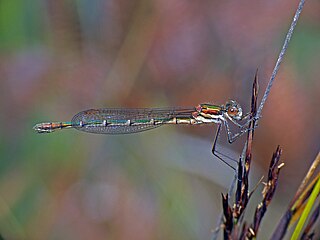
Austrolestes psyche is an Australian species of damselfly in the family Lestidae, commonly known as a cup ringtail. It is found in south-eastern Australia where it inhabits pools, lakes and swamps.

Diphlebia lestoides is a species of Australian damselfly in the family Lestoideidae, commonly known as a whitewater rockmaster. It is endemic to south-eastern Australia, where it inhabits streams and rivers.

Lestoidea brevicauda is a species of Australian damselfly in the family Lestoideidae, commonly known as a short-tipped bluestreak. It is endemic to north-east Queensland, where it inhabits streams in rainforest.

Lestoidea lewisiana is a species of Australian damselfly in the family Lestoideidae, commonly known as a Mount Lewis bluestreak. It has only been recorded at Mount Lewis in north-east Queensland, where it inhabits streams in rainforest.

Lestoidea conjuncta is a species of Australian damselfly in the family Lestoideidae, known as a common bluestreak. It is endemic to coastal north-east Queensland, where it inhabits streams in rainforest.

Austroargiolestes aureus is a species of Australian damselfly in the family Megapodagrionidae, commonly known as a tropical flatwing. It is endemic to north-eastern Queensland, where it inhabits streams in rainforest.
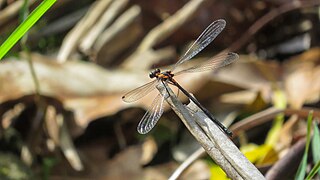
Austroargiolestes amabilis is a species of Australian damselfly in the family Megapodagrionidae, commonly known as a flame flatwing. It is endemic to eastern Australia, where it inhabits streams in rainforest.

Griseargiolestes griseus is a species of Australian damselfly in the family Megapodagrionidae, commonly known as a grey flatwing. It is endemic to south-eastern New South Wales, where it inhabits bogs and seepages near small streams.

Nososticta pilbara is a species of Australian damselfly in the family Platycnemididae, commonly known as a Pilbara threadtail. It has only been found in the Pilbara region of Western Australia, where it inhabits streams and pools.

Nososticta koolpinyah is a species of Australian damselfly in the family Platycnemididae, commonly known as a Koolpinyah threadtail. It has only been found in the vicinity of Darwin and on Melville Island in Northern Territory, where it inhabits streams.

Nososticta koongarra is a species of Australian damselfly in the family Platycnemididae, commonly known as a citrine threadtail. It has only been found on the Arnhem Land escarpment in Northern Territory, where it inhabits streams.

Nososticta taracumbi is a species of Australian damselfly in the family Platycnemididae, commonly known as a Melville Island threadtail. It is endemic to Melville Island, Northern Territory, where it inhabits streams.

Synlestes weyersii is a species of Australian damselfly in the family Synlestidae, commonly known as a bronze needle. It is endemic to south-eastern Australia, where it inhabits streams and rivers.



























